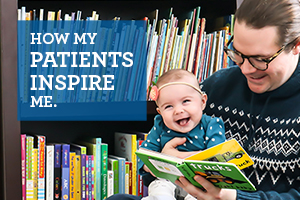Inspire a love of reading
Family Medicine
CentraCare Clinic – Big Lake
Knox in box. Fox in socks.
Knox on fox in socks in box.
Socks on Knox and Knox in box.
Fox in socks on box on Knox.
Say that five times fast. This tongue-twisting excerpt comes from Fox in Socks by Dr. Seuss. I have probably read this 20 times to my daughter, Greta, since she was born. Compared to some children’s books, it’s a pretty engaging read, but any book gets old after so many readings.
To make it fun, my wife and I compete to see who can read this book fastest (I always win by the way). This adds a bit of fun for us while we do one the most important things that can be done for children — reading books aloud. Not only is this a great bonding activity; it also promotes early literacy, language development, scholastic success throughout life, listening skills and both receptive and expressive vocabulary.
I am always inspired in the clinic when I see kids handling the books in the waiting room or exam room. I can usually tell when kids have been read to because even older infants and young toddlers will hold books and try to turn pages if they are familiar with the activity. I am encouraged by seeing parents read aloud because I know the great benefits their children will reap from this simple activity. Seeing children learn and grow inspires me to continue to promote literacy within my clinic practice and with my own child.
To inspire a love of reading in your home, consider the following tips:
- Make reading a part of bedtime routines.
- Make reading fun and engaging by asking questions about what is on the page. This keeps children interested and makes connections between the words on the page and tangible ideas that kids can understand. For example. “Do you see the orange cat? What sound does a cat make?”
- Start early. It is never too early to read to your children. Reading to children in infancy teaches the skills for listening, handling books and recognizing different sounds. The first few years of life are critical to brain development and can set the foundation for future success.
- Kids model their behaviors based on what they see. Demonstrate a positive relationship with books by reading in front of your children.
- Provide positive feedback and goals for reading. One non-profit, called 1,000 Books Before Kindergarten, promotes the goal of — you guessed it — having children read 1,000 books before they start kindergarten (books can be repeated). I think this is a great goal to shoot for. This may seem like a lofty goal but with kids starting kindergarten around age 5, this is less than one book each day. The more books read, the better.
- Come in to CentraCare Clinic – Big Lake for a well-child visit and receive a free book! We provide these through the Reach Out & Read program, which partners with health care organizations to distribute books and promote early literacy.
No matter how you do it, read early and read often.
